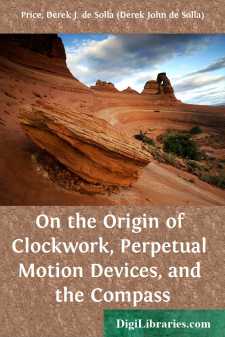Categories
- Antiques & Collectibles 13
- Architecture 36
- Art 48
- Bibles 22
- Biography & Autobiography 813
- Body, Mind & Spirit 142
- Business & Economics 28
- Children's Books 17
- Children's Fiction 14
- Computers 4
- Cooking 94
- Crafts & Hobbies 4
- Drama 346
- Education 46
- Family & Relationships 57
- Fiction 11829
- Games 19
- Gardening 17
- Health & Fitness 34
- History 1377
- House & Home 1
- Humor 147
- Juvenile Fiction 1873
- Juvenile Nonfiction 202
- Language Arts & Disciplines 88
- Law 16
- Literary Collections 686
- Literary Criticism 179
- Mathematics 13
- Medical 41
- Music 40
- Nature 179
- Non-Classifiable 1768
- Performing Arts 7
- Periodicals 1453
- Philosophy 64
- Photography 2
- Poetry 896
- Political Science 203
- Psychology 42
- Reference 154
- Religion 513
- Science 126
- Self-Help 84
- Social Science 81
- Sports & Recreation 34
- Study Aids 3
- Technology & Engineering 59
- Transportation 23
- Travel 463
- True Crime 29
On the Origin of Clockwork, Perpetual Motion Devices, and the Compass
Categories:
Description:
Excerpt
HE histories of the mechanical clock and the magnetic compass must be accounted amongst the most tortured of all our efforts to understand the origins of man's important inventions. Ignorance has too often been replaced by conjecture, and conjecture by misquotation and the false authority of "common knowledge" engendered by the repetition of legendary histories from one generation of textbooks to the next. In what follows, I can only hope that the adding of a strong new trail and the eradication of several false and weaker ones will lead us nearer to a balanced and integrated understanding of medieval invention and the intercultural transmission of ideas.
For the mechanical clock, perhaps the greatest hindrance has been its treatment within a self-contained "history of time measurement" in which sundials, water-clocks and similar devices assume the natural role of ancestors to the weight-driven escapement clock in the early 14th century. This view must presume that a generally sophisticated knowledge of gearing antedates the invention of the clock and extends back to the Classical period of Hero and Vitruvius and such authors well-known for their mechanical ingenuities.
Furthermore, even if one admits the use of clocklike gearing before the existence of the clock, it is still necessary to look for the independent inventions of the weight-drive and of the mechanical escapement. The first of these may seem comparatively trivial; anyone familiar with the raising of heavy loads by means of ropes and pulley could surely recognize the possibility of using such an arrangement in reverse as a source of steady power. Nevertheless, the use of this device is not recorded before its association with hydraulic and perpetual motion machines in the manuscripts of Riá¸ÂwÃÂn, ca. 1200, and its use in a clock using such a perpetual motion wheel (mercury filled) as a clock escapement, in the astronomical codices of Alfonso the Wise, King of Castile, ca. 1272.
The second invention, that of the mechanical escapement, has presented one of the most tantalizing of problems. Without doubt, the crown and foliot type of escapement appears to be the first complicated mechanical invention known to the European Middle Ages; it heralds our whole age of machine-making. Yet no trace has been found either of a steady evolution of such escapements or of their invention in Europe, though the astronomical clock powered by a water wheel and governed by an escapement-like device had been elaborated in China for several centuries before the first appearance of our clocks. We must now rehearse a revised story of the origin of the clock as it has been suggested by recent researches on the history of gearing and on Chinese and other astronomical machines. After this we shall for the first time present evidence to show that this story is curiously related to that of the Perpetuum Mobile, one of the great chimeras of science, that came from its medieval origin to play an important part in more recent developments of energetics and the foundations of thermodynamics. It is a curious mixture, all the more so because, tangled inextricably in it, we shall find the most important and earliest references to the use of the magnetic compass in the West. It seems that in revising the histories of clockwork and the magnetic compass, these considerations of perpetual motion devices may provide some much needed evidence.
Figure 1.—Framework Structure of the Astronomical Clockof Giovanni de Dondi of Padua, A.D. 1364.Power and Motion Gearing
It may be readily accepted that the use of toothed wheels to transmit power or turn it through an angle was widespread in all cultures several centuries before the beginning of our era....


